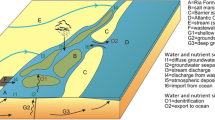Abstract
The tidal exchange of ammonia-nitrogen, nitrate-nitrogen, total nitrogen, total phosphorus, and total organic carbon between coastal lagoons and the marine environment were determined. Constituent measurements were made in Huizache-Caimanero Lagoon in Northwest Mexico over 24-h sampling periods during both dry and wet seasons. The exchange of these nutrients was also compared to exchanges in estuarine marshes of other latitudes. High exchange rates were found to be associated to extreme climatic events.
Similar content being viewed by others
Literature Cited
Arenas, V. 1979. Balance anual del carbono orgánico, nitrógeno y fósforo en el sistema lagunar Huizache Caimanero, Sinaloa, México. Tesis Doctoral, Universidad Nacional Autónoma de México, México. 114 p.
Arenas, V. andG. de la Lanza. 1981. The effect of dried and cracked sediment on availability of phosphorus in a coastal lagoon.Estuaries 4:206–212.
Ayala-Castañares, A., M. Gutierrez, andV. M. Malpica. 1970. Informe final de los estudios de geología marina en las regiones de Yavaros, Son., Huizache y Caimanero, Sin., duranle la primera etapa. Informe Departamento de Ciencias del Mar y Limnología. Instituto de Biología. Universidad Nacional Autónoma de México, México. 190 p.
Boon, J. D., III 1980. Comment on “Nutrient and particulate fluxes in a salt marsh ecosystem: Tidal exchanges and inputs by precipitation and ground water” (Valiela et al. 1978).Limnology and Oceanography 25:182–183.
Carlberg, S. R. 1972. New Baltic Manual, with methods for sampling and analyses of physical, chemical and biological parameters. International Council for the exploration of the sea, Charlottenlund, Denmark, 145 p.
Fan, A. andX. Jin. 1989. Tidal effect on nutrient exchange in Xiangshan Bay, China.Marine Chemistry 27:259–281.
Grivel-Piña, F. 1989. Tablas de predicción de mareas 1989. Puertos del Oceáno Pacífico. Datos geofisicos Serie A. Ocean-ografia. Instituto de Geofisica, Universidad Nacional Autónoma de México, México, D. F., 415 p.
Heinle, D. R. andD. A. Flemer. 1976. Flows of material between poorly flooded tidal marshes and an estuary.Marine Biology 35:359–373.
Knauss, J. A. 1978. Introduction to Physical Oceanography. Prentice Hall, Englewood Cliffs, New Jersey. 338 p.
Mendoza vön Borstel, X. 1972. Efectos de la marea sobre la producción camaronera en lagunas litorales, p. 407–418.In Memorias del IV Congreso Nacional de Oceanografia (México).
Odum, E. P. andA. A. de la Cruz. 1967. Particulate detritus in a Georgia salt marsh estuarine ecosystem, p. 383–388.In G. H. Lauff (ed.), Estuaries. American Association for the Advancement of Science, Washington, D. C.
Pomeroy, L. R., R. E. Johannes, E. P. Odum, and B. Roffman. 1969. The phosphorus and zinc cycles and productivity of a salt marsh, p. 416–419.In D. J. Nelson and F. C. Evans (eds.), Proceedings of National Symposium on Radioecology 1967. Ann Arbor, Michigan.
Pritchard, D. W. andH. H. Carter. 1971. Classification of estuaries: Classification according to physical processes, p. 9–11.In J. R. Shubel (ed.), The Estuarine Environment; Estuaries and Estuarine Sedimentation. Short Course Lecture Notes. American Geological Institute, Washington, D.C.
Raz-Guzman, M. L. A. andM. R. A. Sosa-Luna. 1982. Evolución de la degradación de la vegetación halofita y su importancia en el sistema lagunar Huizache-Caimanero, Sin., México. Tesis Professional, Universidad Nacional Autónoma de México, México. 97 p.
Rodríguez-Medina, M. 1989. Estudioin situ de la degradación de la halofitaSalicornia subterminalis y su relación con los mecanismos de movilización de nutrimentos a través de la interfase sedimento-agua en el sistema lagunar Caimanero-Huizache, Sin., México. Tesis Doctoral, Universidad Nacional Autónoma de México, México. 152 p.
Serra, S. C. 1971. Hurricanes and tropical storms of the west coast of Mexico.Monthly Weather Review 99:303–308.
Soto, L. R. 1969. Mecanismo hidrológico del sistema de lagunas litorales Huizache-Caimanero y su influencia sobre la producción camaronera. Tesis Profesional, Universidad Autónoma de Baja California. México. 79 p.
Valiela, I., J. M. Teal, S. Volkmann, D. Shafer, andE. J. Carpenter. 1978. Nutrient and particulate fluxes in a salt marsh ecosystem: Tidal exchanges and inputs by precipitation and ground water.Limnology and Oceanography 23:798–812.
Author information
Authors and Affiliations
Rights and permissions
About this article
Cite this article
Espino, G.d.l.L., Medina, M.A.R. Nutrient exchange between subtropical lagoons and the marine environment. Estuaries 16, 273–279 (1993). https://doi.org/10.2307/1352500
Received:
Accepted:
Issue Date:
DOI: https://doi.org/10.2307/1352500




